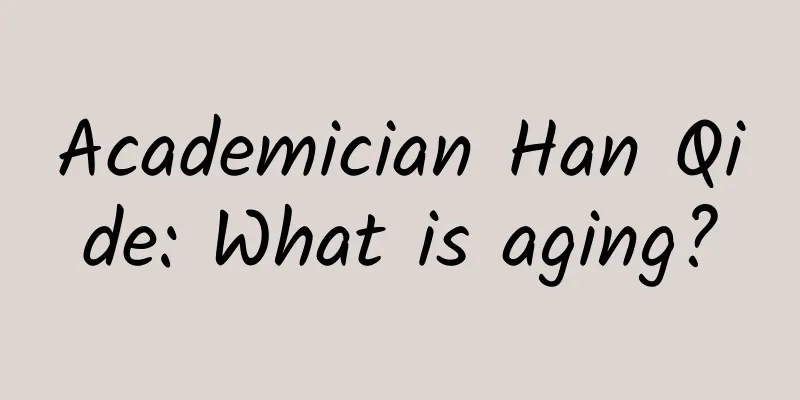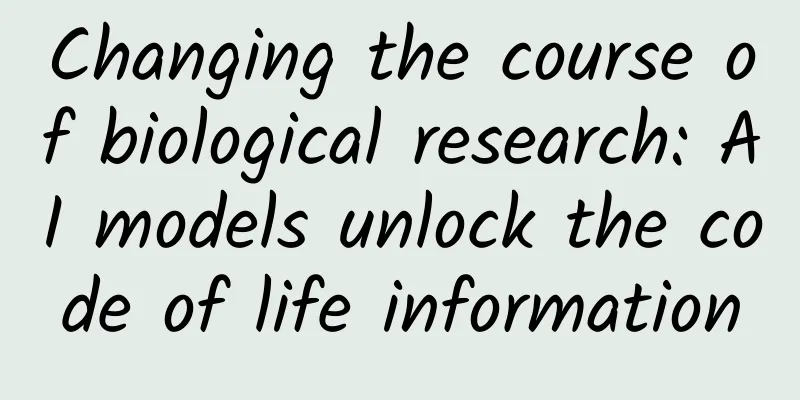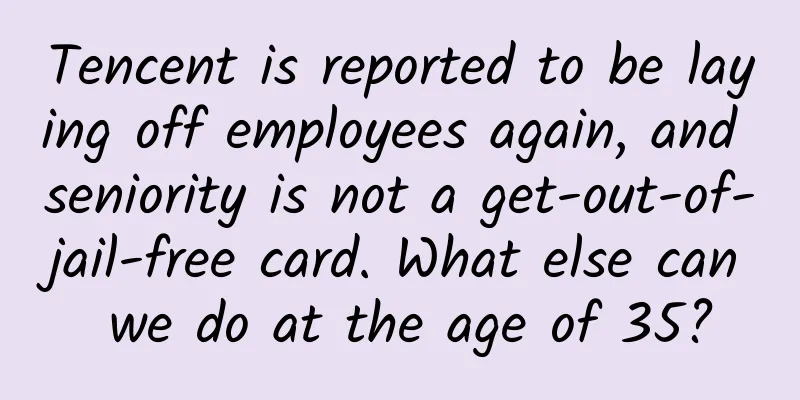Academician Han Qide: What is aging?

|
Author: Han Qide, pathophysiologist, academician of the Chinese Academy of Sciences, honorary chairman of the China Association for Science and Technology People often say: "Love is an eternal theme", but in fact, death is an even more "eternal theme". The reason why it is "eternal" is that it is "unsolvable" and no one has ever really experienced "death". Secondly, it is important. In the words of Professor Wang Yifang, if we do not solve the understanding of death, we will always live in fear of death, and we will be extremely painful when we die. From a social perspective, fear of death is still an important source of over-medicalization and excessive rescue in the terminal stage. I have discussed my understanding of death in an article titled “Perception of Death” three years ago, which has been included in my book “The Temperature of Medicine”. Today I want to focus on another issue closely related to death: aging. Like death, aging is inevitable and a long slope in life. Except for those who die prematurely due to various reasons, most people will die through aging. Aging is the prelude to death. What is aging? The World Health Organization defines aging as "a process in which various molecular and cellular damages accumulate gradually over time". The famous medical humanities writer Gawande uses vivid cases to show that "aging is a series of continuous functional losses". Thomas Jefferson of the United States wrote to John Adams, who was 78 years old, when he was 71 years old, very vividly: "Our machine has been running for seventy or eighty years, and it is foreseeable that it will break down. An axle here, a wheel there, a gear now, a spring next, will fail. Although we can repair it temporarily, it will eventually stop working." ►►► Aging is both an independent state and interdependent with disease Figuratively speaking, aging and disease are two trains running on two tracks, but they may change tracks or merge at any time. On the one hand, aging is a hotbed of disease, which will form and accelerate certain diseases; on the other hand, disease may promote the process and degree of aging. But whether there is disease or not, at a certain age, the body will be in a continuous aging process without exception. When aging accumulates to a certain extent, it usually slides into a state of "dying without illness". Of course, it is not ruled out that the disease acts as a "trigger" and triggers the "domino effect". In medical terms, it evolves from multiple organ weakness to multiple organ failure. Between aging and death, there is a period called deep aging, medically known as the end of life, which is also the stage where palliative care is put into practice. In the past, it was called "hospice care", but in April 2016, the CPPCC biweekly meeting proposed to change it to "palliative care". Palliative care is very important and is related to the quality of each person's life at the end. ►►► Aging is a process that occurs in all parts of the body. It only happens at different times in different people, and the order is different. 1. The most common and prominent manifestation of aging is the narrowing of blood vessels throughout the body and insufficient blood supply to organs, which leads to reduced function or even weakening of various organs. Among them, severe atherosclerotic lesions in the cardiovascular system lead to myocardial infarction and stroke. 2. As we age, our immune function generally declines and our ability to resist infection is reduced. The invasion of a small amount of pathogenic microorganisms can easily lead to serious infection, which manifests itself in multiple organs, especially the lungs. 3. As we age, the levels of multiple hormones decrease, leading to muscle atrophy and weakness, osteoporosis, and easy falls and fractures. 4. As we age, the number of brain cells and the connections between them decrease, and memory declines. In severe cases, it can lead to mental disorders such as dementia, and dementia and amnesia will occur one after another. 5. The chances of errors in gene replication, transcription, and translation increase with aging. Errors accumulate, and the ability to correct errors weakens due to decreased immunity, greatly increasing the risk of cancer. All of these not only manifest as a decline in various physiological functions, but also often lead to a variety of diseases. It can be said that aging provides a broad background for diseases. ►►► Aging not only increases the incidence of diseases, but also significantly changes the nature and pathological process of diseases. For the same disease, the clinical manifestations, treatment responses and outcomes of the elderly may be very different from those of the non-elderly. For example, even when the elderly have a serious infection, they may not have a high fever and their white blood cell count may not increase significantly. For example, their tolerance to surgical shock and drug side effects is significantly reduced. Therefore, the diagnosis and treatment of diseases in the elderly should be different from those in the general adult population. We do not pay enough attention to this in clinical practice, which often affects the quality of medical care and even causes accidents. ►►► Aging is a comprehensive process, with multiple organ functions being lost one after another. Elderly people often have multiple diseases coexisting. Therefore, when treating elderly patients, we must pay more attention to systematic analysis, distinguish the primary from the secondary, and resolve the main contradictions. If we diagnose and treat each disease one by one, we will inevitably lose sight of one thing while focusing on another, or even conflict with each other, which will bring serious consequences. We now see that many elderly people take 7-8 or even more than a dozen kinds of medicine a day. This is the result of specialized diagnosis and treatment. Each doctor only takes care of patients with a certain system or organ, and there is a lack of coordination. All drugs have toxic side effects, and these side effects also have cumulative effects. Even if the toxic side effects are not obvious, the effects of various drugs may conflict with each other. Therefore, taking multiple drugs at the same time is often harmful to the body. Therefore, geriatric medicine experts have reached a consensus that the elderly should not take more than 5 drugs at the same time every day. ►►► Since we lose multiple organ functions during aging, most of which cannot be restored to normal, we must learn to "coexist peacefully" with them. For example, studies have shown that as men age, the possibility of prostate cancer lesions gradually increases. Among corpses autopsied for other causes of death, the detection rate of prostate cancer lesions in people over 70 years old is as high as 82%. In the autopsies of female corpses, it was found that the presence of cervical cancer, breast cancer and other lesions in the elderly also accounted for a considerable proportion. For such cancer lesions, compared with other lesions in the bodies of the elderly, it is really not a big problem and can "coexist peacefully". On the contrary, if we continue to increase the intensity of screening and adopt "encirclement and suppression" treatment for such lesions, it will bring great damage to the body and mind. As we age, the loss of functions of all organs in the body will inevitably lead to diseases, either here or there; in the end, it is either this serious disease or that serious disease that leads to our death. In fact, it is not a specific disease that causes our death, but the real cause of death is aging, because we have been exhausted and are destined to collapse. It's just that we are now accustomed to artificially finding a disease as the cause of death, and denying "death from old age" and "death from old age". How to delay aging? We are not completely helpless against aging. We can prevent premature aging caused by unhealthy lifestyles and even delay the aging process to a certain extent. For example, smoking, drinking, overeating, sitting for long periods of time, etc. will definitely accelerate aging. If we change these bad habits, we can relatively delay aging. We can also actively explore some healthy lifestyles. In this regard, there have been many introductions, so I will just talk about my personal experience. 20 years ago, my lumbar spine had degenerative lesions, which progressed thereafter. Eight years ago, I developed serious symptoms. Although the symptoms were alleviated through conservative treatment, low back pain has become a normal part of my life. My digestive and absorption abilities, which I thought I could do with iron, have declined significantly. My body has become thinner and thinner, and my arms and legs have become thinner and thinner. My eyesight, which I was always proud of, has gradually dropped from 1.5 to 0.7, and I have cataracts. There are more than 20 abnormalities listed in the physical examination summary report, including 4-5 suspicious shadows in imaging (among which prostate cancer is highly suspected), elevated indicators of multiple tumor markers, and abnormal immune cell function. The obvious acceleration of the aging process prompted me to start fitness training three years ago, 2-3 times a week. I am happy to see that my body has improved rapidly, my muscles have developed, I stand up straight, and all functions have improved. Friends praised me for "not looking old", and I also felt that the pace of aging has slowed down. When I was young, I read Jin Yong's martial arts novels and often sighed that the old martial arts masters in the book who had white hair and youthful faces were not only agile, fast punches and strong legs, but also had smooth waist and abdomen movements. I guess it was not because of the secret book reading or the elixir carrying with them, but because of the continuous practice in cold and hot weather. The spiritual meaning of aging also needs to be explored in depth The above are all about physiological aging issues, but I think the spiritual meaning of aging also needs to be explored in depth, as the spiritual and physiological aspects are closely related. Facing the same aging situation, the loss of physiological functions one by one, and the increasing number of chronic diseases that come with aging, different people have different attitudes. Some people accept it calmly, deal with it calmly, and maintain their love and passion for life, just like the silver-haired members of the Tsinghua Shanghai Alumni Association Chorus, who are full of passion and "still young after returning"; others are in panic about their bodies and diseases all day long, and feel frustrated, disordered, and lost by the ups and downs of life. Different attitudes depend on the understanding of life, living and death and the corresponding mental state; this also affects the quality of life in later years and even the aging process. Aging is accompanied by the loss of a series of physiological functions and the pain of diseases. However, from a spiritual perspective, people go through the stages of childhood, adolescence, youth and middle age, see the world, and go through trials and tribulations. Their minds and thoughts become more mature, and they can better understand the true meaning of life. If they practice well, they can be as calm as water, not be surprised by honor or disgrace, be detached from all kinds of frustrations and losses in life, see through the world, and be content with the circumstances. This state is something that ordinary young people cannot reach. In this regard, Chinese cultural tradition has very unique insights and expressions. The poem by Tang Dynasty poet Liu Yuxi most vividly illustrates this truth. The first half of the poem describes the physical state of aging: "Who doesn't care about aging? Who will pity the old? The body is tired and the belt is often worn out. The hair is thinning and the crown is crooked. I give up reading to save my eyes and do more moxibustion to follow my age." But in the second half of the poem, his true spiritual world is revealed: "After experiencing things, I still understand things. After seeing people, it's like seeing a river. I am lucky to think carefully. After this, I will be relaxed. Don't say that the sun is setting, the sky is still full of clouds." Yes, the setting sun is shining, the sky is full of red clouds, only the green is here, the past is vivid, the old friends are cherished, let go of everything, and welcome the new life. What a beautiful scene! At present, we live in the torrent of the information age. Various information about life knowledge and life attitudes are pouring in and are all around us. If we take the perception and discussion of aging, the eternal topic of mankind, as the topic, how should we grasp it? Which is "old" and which is "new"? Modern life knowledge is definitely new, but is the ancient and vital spiritual realm, or life attitude, also constantly reminding and caring for us at the level of human wisdom? Dear elderly friends, let us grow old and live happily! |
<<: Lose! Hair! Can! Cure! See if you belong to this 90%, come and check your name...
>>: Are the cotton swabs used for nucleic acid testing poisonous? Rumor!
Recommend
How effective are Estee Lauder skincare products?
The editor’s skin care products are mainly Estee ...
Douyin promotion: Douyin traffic pool brings goods, and the business of Internet celebrities is really good
After becoming a super user traffic pool, it is n...
Check the price of Shigatse marriage and love mini program agent. How much is the price of Shigatse marriage and love mini program agent?
How much does it cost to be an agent for a marria...
Understand iQiyi’s regional brand marketing in one picture!
In the era of big screens, smart TVs are highly p...
Channel promotion and operation strategy, 3 tricks to double your customer acquisition!
This article takes free channels as an example, a...
Shengyao Cross-border "How to do Amazon e-commerce" teaches you how to make money on Amazon in seven days
Training course content: Teach you how to easily ...
Double Eleven video material creative guide!
This article brings you the "11.11 Video Mat...
Some slightly more advanced uses of CocoaPods
[[150180]] I remember when I first started iOS de...
From 0 to 1, play with short video promotion and operation on Tik Tok!
Today we will share the following 5 major section...
4.3 million was defrauded in 10 minutes? AI fraud has these unexpected methods
Recently, the topic #AI fraud is breaking out acr...
Getting Started with Independent Game Development (1)
[[142925]] Newton's third law tells us that i...
Operational plan for the Double Eleven marketing activities of educational institutions
Double Eleven every year is not only a shopping c...
If you suddenly stand up and feel dizzy, don't take it lightly, it may be a sign of illness.
If you stand up suddenly after squatting, you may...
Case | oCPC advertising optimization strategy effectively reduces conversion costs
In this case, an advertiser in the education and ...
Light Lesson - Comic Line Draft Introduction - Anime Drawing for Beginners
Qingwei Class - Introduction to Comic Line Draft ...









